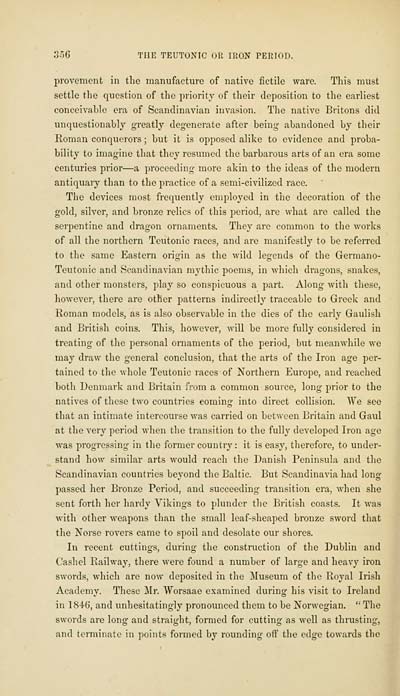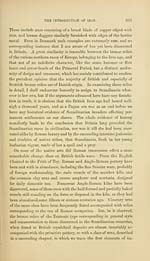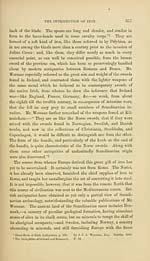Download files
Complete book:
Individual page:
Thumbnail gallery: Grid view | List view

356 THE TEUTONIC OR IRON PERIOD.
provement in the manufacture of native fictile ware. This must
settle the question of the priority of their deposition to the earliest
conceivable era of Scandinavian invasion. The native Britons did
unquestionably greatly degenerate after being abandoned by their
Roman conquerors ; but it is opposed alike to evidence and proba-
bility to imagine that they resumed the barbarous arts of an era some
centuries prior — a proceeding more akin to the ideas of the modern
antiquary than to the practice of a semi-civilized race.
The devices most frequently employed in the decoration of the
gold, silver, and bronze relics of this period, are what are called the
serpentine and dragon ornaments. They are common to the works
of all the northern Teutonic races, and are manifestly to be referred
to the same Eastern origin as the wild legends of the Germano-
Teutonic and Scandinavian mythic poems, in Avhich dragons, snakes,
and other monsters, j^lay so conspicuous a part. Along with these,
however, there are other patterns indirectly traceable to Greek and
Roman models, as is also observable in the dies of the early Gaulish
and British coins. This, however, will be more fully considered in
treating of the personal ornaments of the period, but meanwhile we
may draw the general conclusion, that the arts of the Iron age per-
tained to the whole Teutonic races of Northern Europe, and reached
both Denmark and Britain from a common source, long prior to the
natives of these two countries coming into direct collision. We see
that an intimate intercourse was carried on between Britain and Gaul
at the very period when the transition to the fully developed Iron age
was progressing in the former country : it is easy, tlierefore, to under-
stand how similar arts would reach the Danish Peninsula and the
Scandinavian countries beyond the Baltic. But Scandinavia had long-
passed her Bronze Period, and succeeding transition era, when she
sent forth her hardy Vikings to plunder the British coasts. It was
with other weapons than the small leaf-sheaped bronze sword that
the Norse rovers came to spoil and desolate our shores.
In recent cuttings, during the construction of the Dublin and
Cashel Railway, there were found a number of large and heavy iron
swords, which are now deposited in the Museum of the Royal Irish
Academy. These ]\Ir. Worsaae examined during his visit to Ireland
in 1846, and unhesitatingly pronounced them to be Norwegian. " The
swords are long and straight, formed for cutting as well as thrusting,
and terminate in points formed by rounding off the edge towards the
provement in the manufacture of native fictile ware. This must
settle the question of the priority of their deposition to the earliest
conceivable era of Scandinavian invasion. The native Britons did
unquestionably greatly degenerate after being abandoned by their
Roman conquerors ; but it is opposed alike to evidence and proba-
bility to imagine that they resumed the barbarous arts of an era some
centuries prior — a proceeding more akin to the ideas of the modern
antiquary than to the practice of a semi-civilized race.
The devices most frequently employed in the decoration of the
gold, silver, and bronze relics of this period, are what are called the
serpentine and dragon ornaments. They are common to the works
of all the northern Teutonic races, and are manifestly to be referred
to the same Eastern origin as the wild legends of the Germano-
Teutonic and Scandinavian mythic poems, in Avhich dragons, snakes,
and other monsters, j^lay so conspicuous a part. Along with these,
however, there are other patterns indirectly traceable to Greek and
Roman models, as is also observable in the dies of the early Gaulish
and British coins. This, however, will be more fully considered in
treating of the personal ornaments of the period, but meanwhile we
may draw the general conclusion, that the arts of the Iron age per-
tained to the whole Teutonic races of Northern Europe, and reached
both Denmark and Britain from a common source, long prior to the
natives of these two countries coming into direct collision. We see
that an intimate intercourse was carried on between Britain and Gaul
at the very period when the transition to the fully developed Iron age
was progressing in the former country : it is easy, tlierefore, to under-
stand how similar arts would reach the Danish Peninsula and the
Scandinavian countries beyond the Baltic. But Scandinavia had long-
passed her Bronze Period, and succeeding transition era, when she
sent forth her hardy Vikings to plunder the British coasts. It was
with other weapons than the small leaf-sheaped bronze sword that
the Norse rovers came to spoil and desolate our shores.
In recent cuttings, during the construction of the Dublin and
Cashel Railway, there were found a number of large and heavy iron
swords, which are now deposited in the Museum of the Royal Irish
Academy. These ]\Ir. Worsaae examined during his visit to Ireland
in 1846, and unhesitatingly pronounced them to be Norwegian. " The
swords are long and straight, formed for cutting as well as thrusting,
and terminate in points formed by rounding off the edge towards the
Set display mode to: Large image | Transcription
Images and transcriptions on this page, including medium image downloads, may be used under the Creative Commons Attribution 4.0 International Licence unless otherwise stated. ![]()
| Early Gaelic Book Collections > J. F. Campbell Collection > Archaeology and prehistoric annals of Scotland > (398) |
|---|
| Permanent URL | https://digital.nls.uk/78376070 |
|---|
| Description | Volumes from a collection of 610 books rich in Highland folklore, Ossianic literature and other Celtic subjects. Many of the books annotated by John Francis Campbell of Islay, who assembled the collection. |
|---|
| Description | Selected items from five 'Special and Named Printed Collections'. Includes books in Gaelic and other Celtic languages, works about the Gaels, their languages, literature, culture and history. |
|---|

